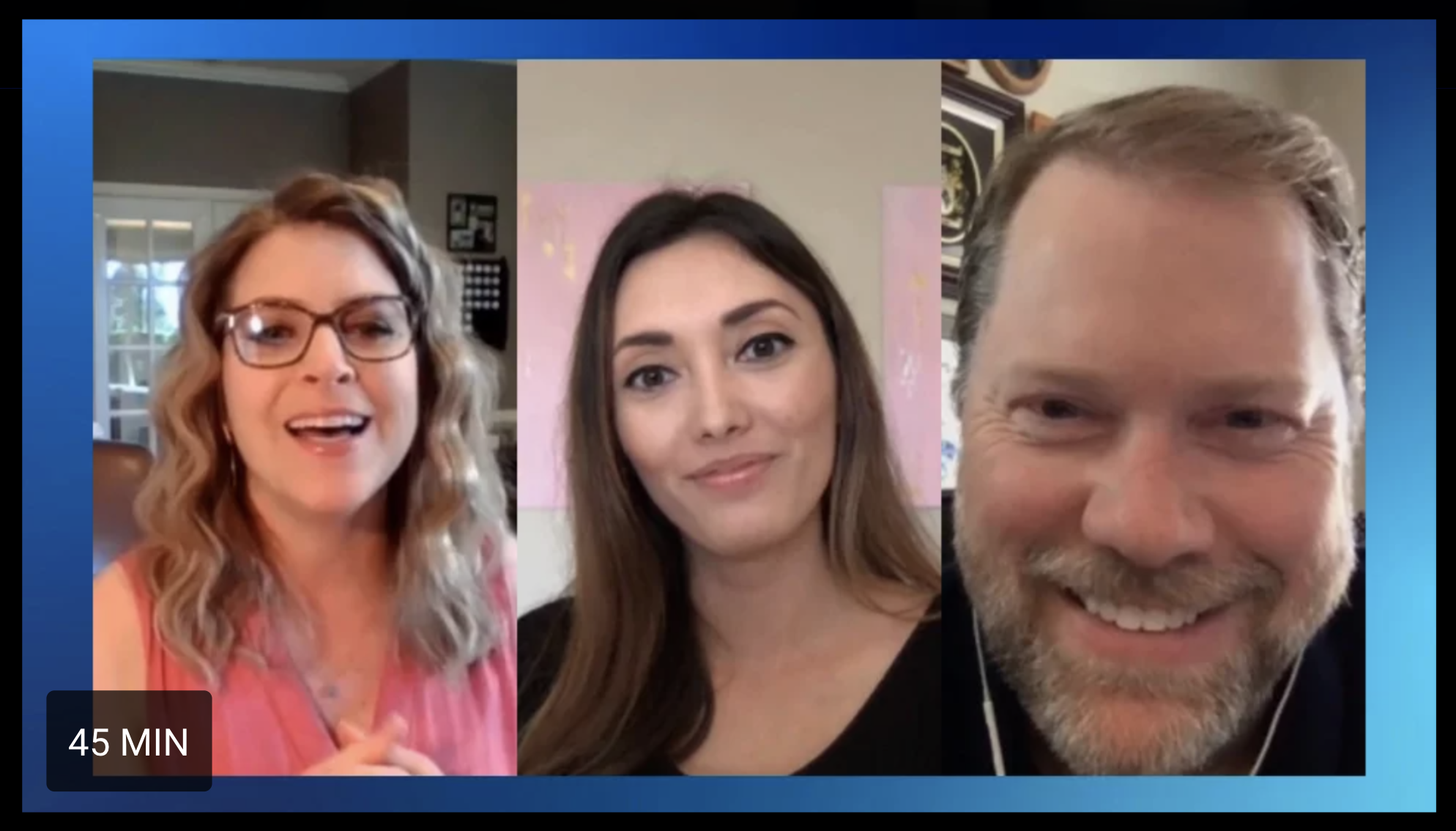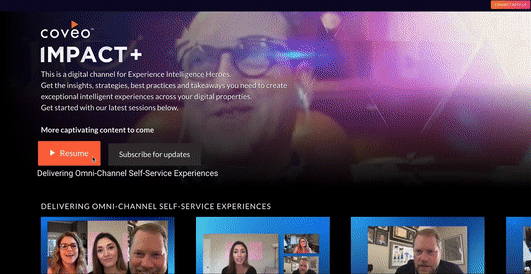Newly released on Impact+, “Delivering Omni-Channel Self-Service Experiences” shows you how to create an effortless customer experience across all digital channels.
While theory is valuable, we know it’s just not enough to generate actionable understanding, which is why we invited Laurel Poertner (Director of Knowledge Service at F5) and Jeff Harling (AVP at RingCentral) to join us for this live session. In it, they reveal how their organizations actually went about creating seamless experiences for their customers so that you might be able to do the same.
Now, if you’d rather explore all that is possible through the written word, you’ve come to the right place.
Every course of action has a reason for being, so after the usual introductions, moderator Bonnie Chase (Senior Product Marketing Manager at Coveo) asked Laurel and Jeff to kick things off by answering an important question:
Organizational Readiness: What prompted the move to create an omni-channel customer service experience?
For RingCentral, the move to develop and implement a strategy to create such an experience came from the need to differentiate themselves from their competition beyond the product – and they determined that enhancing service provision was key to doing so. However, improving service necessitated that they offer more channels and capabilities to meet customer demand, which, in turn, required finding a way to manage the increasing number of channels and customer movement between them so as to avoid fragmentation.
“Enhancing and maximizing our service experience meant that we needed to offer more channels and more capabilities that customers were demanding.” – Jeff Harling, AVP, @RingCentral #selfservice pic.twitter.com/AiLcbtZVVP
— Coveo (@coveo) June 18, 2020
And for F5, the trigger was very similar. With the shift to a SaaS environment, they saw that the great customer experience they had once delivered was falling behind new expectations – people had been conditioned to expect an effortless and unified service experience across a growing number of channels. They saw that their competition was getting ahead of them in meeting that demand, compelling them to adjust to compete.
It became clear to both of them that creating an omni-channel service experience was necessary to compete in a new technological landscape, and the next step in making that a reality was obtaining buy-in from key stakeholders.
Future Thinking Buy-In: How do you build a business case for omni-channel customer service?
Getting buy-in for an omni-channel strategy is a top-down process that starts with getting executive sponsorship. The support of leadership is necessary to generate the overarching internal mentality that the shift is necessary, so that everyone involved in the organization feels compelled to embrace and adopt the changes necessary for a successful transition. New tools and capabilities won’t help achieve anything if the people that are supposed to operate them don’t see the purpose or value in doing so.
And buy-in can’t simply come from one department, it must come from across the business – marketing, sales, and service & support – as organizational alignment is essential to achieving the business outcomes associated with an omni-channel strategy.
F5 took an innovative approach to getting leadership to understand the value of an omni-channel experience and evangelize it to the rest of the organization. Laurel explained that they formed a Center of Excellence to bring together business leaders who worked closely with customers and digital properties to discover exactly what would be needed to improve the customer experience. They settled on customer effort. They wanted to make it easier for customers to do business with them, and an omni-channel approach to service proved to be the way to move forward with making that happen.
Although getting support from leadership helps with bringing the rest of the organization on board, Jeff shared that additional effort on the part of his team really helped more broadly communicate the importance of the project and bring everyone into alignment to ensure that it would be a success.
Once everyone is on board, a strategy can be formed that takes all priorities and objectives into account.
Developing an Omni-Channel Strategy: What metrics should you use to measure success?
Laurel and Jeff pointed to a number of different metrics that you can use to measure success and the questions that they answer:
- Scalable Growth: Are we able to grow as a company without service/support needing to grow at the same rate?
- Adoption of Digital Tools: Are customers using the digital tools and channels available for support – chatbots and social media – or are they falling back on traditional methods such as phone calls and emails? Are site visits high – what about chat adoption?
- Search Engine Usage and Queries: What are agents searching for to answer questions? Are customers seeing no results for simple queries?
- Content Usefulness and Case Deflection: What are users doing digitally? Are they engaging with content – if so, does it answer their question or do they escalate and contact support? (RingCentral) Are customers voting thumbs up or thumbs down on a piece of content after looking at it?
According to Jeff Harling, AVP @RingCentral, content usefulness was key to starting to develop an #omnichannel strategy. “Content has probably been the primary focus for our team. If we have a strong content practice, all of the tools will begin to work better.”#selfservice pic.twitter.com/gZMXQ99bxk
— Coveo (@coveo) June 18, 2020
Although the metrics above measure performance in different areas and answer different questions, they are all reflective of the same thing – the ability to provide people with the content they need when they ask for it. And those metrics also point to where strategic efforts need to be focused if you find yourself falling short. In other words, those metrics reveal what content needs to be created, how it should be created, and where it should live.
Content and Channels: How should you approach knowledge management for omni-channel customer service?
Content is key to creating an exceptional omni-channel experience. In fact, Jeff noted that creating well-structured, well-tagged content has allowed RingCentral to fill their knowledge gaps so that their customers and agents can find the information they need regardless of the channel they use – whether it be the chatbot, website, or search engine. But, as Laurel pointed out, in addition to creating great content, it is also necessary to develop context, as that is the only way to ensure that the right content ends up in the right hands. Two different people might be looking for vastly different things even if they are asking the same question.
In the abstract, creating content and developing context sounds far more complicated than it actually is. Thankfully, Laurel and Jeff perfectly captured what this process looks like in practice.
It involves adopting Knowledge Centered Service (KCS):
And enhancing the execution of KCS practices with Coveo capabilities:
Moving from getting buy-in, to developing an omni-channel strategy and properly implementing it takes time. So you may be wondering how long it takes to actually start having a positive effect.
Outcomes: How long does it take to see results?
Both Laurel and Jeff saw positive results almost immediately. Time to adoption certainly wasn’t uniform across all components, but they both touched upon areas where improvement can be seen right off the bat as the result of implementing an omni-channel strategy.
For RingCentral, this instantaneous improvement was seen in the search engine space after implementing Coveo. Their click through rate rose rapidly as the result of enhancing search capabilities and obtaining the ability to easily tune results. And in joining their search effort together with their content rejuvenation effort, they saw their view rate increase 300% in just 9 months. The benefit of adopting an omni-channel strategy is that both information and success do not remain siloed.
For F5, analytics was the real game-changer, as it generated actionable insights into customer behavior. Despite having great content, they found that customers were traveling to multiple different sites to find the content they actually needed because it wasn’t located where they had originally gone to find it. As a result, F5 decided to unify content throughout the organization, and now they are able to meet people where they are to give them what they need.
After exploring outcomes, a live Q+A then followed where both Laurel and Jeff responded to a question from the audience: What roles on your teams have changed, grown or been completely transformed because of this new strategy?
To hear their answers and to learn more about everything that goes into and comes out of an omni-channel customer service strategy, be sure to check out the full recording. And once you’re done, our next episode on measuring and optimizing for service success is waiting for you.
Dig Deeper
Want to experience F5 and RingCentral’s success for yourself? To learn more about what you need to do – and how – watch our webinar: How Digital Leaders are Transforming Their Customer Service with AI.
Hopefully, we’ll be telling your success story soon.



